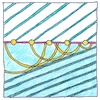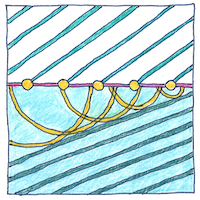Christiaan Huygens,
Augustin-Jean Fresnel
optics

|
Huygens—Fresnel principle
Huygens considered light to be a luminous disturbance of springy corpuscles of ether propagated by spherical waves from each point in its path that add up to determine light’s direction. Huygen’s principle explained reflection and refraction, but not defraction. Fresnel explained defraction by adding to Huygen’s principle that observation that light waves interfere with each other.
Arago spot
The spot that shouldn’t exist in the center of a circular shadow helped show that light behaves like waves.
Geometry of corpuscles
Huygens applied compass and ruler, geometric methods, to mythical corpuscles of ether. It should perhaps be claimed that what he made was not a description of light but a paper and pencil model of it.



Fresnel, working a hundred and thirty years after Huygens, expressed the circular disturbances made by each corpuscle of ether mathematically. The theory may seem archaic; however, it still predicts the behavior of electromagnetic disturbances in quantum field theory.
See also in The book of science:
Readings in wikipedia:
Other readings: